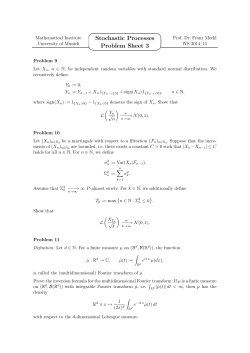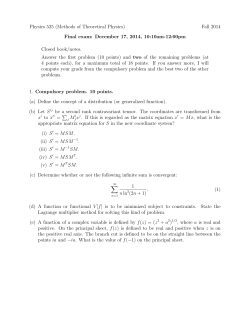
DIGITAL SIGNAL PROCESSING
SIGNALS and SYSTEMS – EHB252E (CRN 20823) Spring 2015- Course Syllabus Instructor: Assoc.Prof. Ender M. Ekşioğlu, eksioglue at itu.edu.tr, Office: 2401 Lecture hours and place: Thursday, 13:30-16:30, EE5104 Office hours for lecturer: Tuesday 10:00-12:00 Teaching Assistant: MSc. Özden Bayır, Office: 3104, bayiroz at itu.edu.tr, Office hours for TA: Wednesday 14:00-16:00 Prerequisite: Arithmetic of complex numbers, differential and integral calculus. Website: Assignments etc. will be posted on the class website announced in class. Textbook: “Signals and Systems”, A. V. Oppenheim, A. S. Willsky and S. H. Nawab. 2nd edition, Prentice Hall, 1997. Some reference texts: Signals and Systems: Analysis Using Transform Methods and MATLAB”, M. J. Roberts, 2nd edition, McGraw-Hill, 2012. “Signals and Systems”, Hwei Hsu, Schaum’s Outline, McGraw-Hill, 2013. “Sinyaller ve Sistemler”; A. V. Oppenheim, A. S. Willsky ve S. H. Nawab. 2. basımdan çeviri; Akademi Yayıncılık; 2008. “Signals and Systems”, Simon Haykin and Barry van Veen. John Wiley and Sons, 2002. To be able to take the final (not to get a VF grade): - Attend at least 10 (out of 14) lectures -Attend both of the midterms (unless there is a proven excuse) -Get at least 20% percent of the points available for the in term activities Homework: A due date will accompany each homework assignment. You will be neither excused from nor granted any extension for an assignment without prior approval from the instructor. Quizzes: There will be pop quizzes during the class hours. Academic Integrity: Homework and examinations are expected to be the sole effort of the student submitting the work. Cheating will not be tolerated. Grading criteria: Percent of final grade Homework and Quizzes: 10% Midterm 1: 25% Midterm 2: 25% Final exam (cumulative): 40% Reading Assignments OW: OppenheimSignals and Systems. Continuous-Time and Discrete-Time Signals. Willsky Transformations of the Independent Variable. Exponential and Rob: M. J. Roberts Sinusoidal Signals. The Unit Impulse and Unit Step Functions. OW Ch.1 Continuous-Time and Discrete-Time Systems. Rob. Ch. 1, Ch. 2 Basic System Properties. Linear Time-Invariant Systems. DiscreteOW Ch. 2.1-2.2 Time LTI Systems: The Convolution Sum. Continuous-Time LTI Rob. Ch. 3 Systems: The Convolution Integral. Properties of Linear Time-Invariant Systems. Causal LTI Systems OW Ch. 2.3-2.4 described by Differential and Difference Equations. Rob Ch. 4, 5 Fourier Series Representation of Periodic Signals. The Response of LTI Systems to Complex Exponentials. Fourier Series Representation OW Ch. 3.1-3.5 of Continuous-Time Periodic Signals. Convergence of the Fourier Rob Ch. 6.1-6.2 Series. Properties of Continuous-Time Fourier Series. The Continuous-Time Fourier Transform. Properties of the Continuous-Time Fourier Transform. The Convolution Property. OW Ch. 4.1-4.7 Tables of Fourier Properties and Basic Fourier Transform Pairs. Rob Ch. 6.3-6.4 Systems Characterized by Differential Equations. The Discrete-Time Fourier Transform. Properties of the Discrete-Time OW Ch. 3.6-3.7 Fourier Transform. The Convolution Property. The Multiplication OW Ch. 5.1-5.8 Property. Tables of Fourier Transform Properties and Basic Fourier Rob Ch. 7.1-7.5 Transform Pairs. Duality. MIDTERM EXAM Systems Characterized by Linear Constant-Coefficient Difference OW Ch5;Rob Ch7 Equations. Discrete Fourier Transform. Extension probs. The Magnitude-Phase Representation of the Frequency Response of OW Ch. 6.1-6.7 LTI Systems. Time-Domain Properties of Ideal Frequency-Selective Rob Ch. 11.1-11.3 Filters. First-Order and Second-Order Continuous-Time Systems. Sampling. The Sampling Theorem. Reconstruction of a Signal from Its OW Ch. 7.1-7.4 Samples Using Interpolation. Aliasing. Discrete-Time Processing of Rob Ch. 10.1-10.2 Continuous-Time Signals. The z-Transform. The Region of Convergence for the z-Transform. OW Ch. 10.1-10.5 The Inverse z-Transform. Properties of the z-Transform. Some Rob Ch. 9.1-9.12 Common z-Transform Pairs. Block Diagram Representations. Holiday MIDTERM EXAM OW Ch. 10.6-10.7 Analysis and Characterization of LTI Systems Using z-Transforms. Rob. Ch. 14.1-14.4 Week Topic (tentative) 1 2 3 4 5 6 7 8 9 10 11 12 13 14
© Copyright 2025



![[ ] sin [ ] - Oregon State University](http://cdn1.abcdocz.com/store/data/000701149_1-0bf1cae8507d705aa8597319f112cba3-250x500.png)







